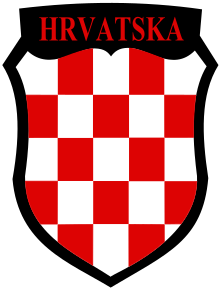392nd (Croatian) Infantry Division
The 392nd (Croatian) Infantry Division , also known as the Blue Division ( Croatian Plava divizija ), was a major unit of the Wehrmacht , which, as part of the so-called "Croatian Legion" , was manned by soldiers from the Independent State of Croatia (NDH) and by German officers was conducted. It was erected in 1943, used in the fight against Tito partisans from 1944 and surrendered in 1945.
history
As the last of three German-Croatian infantry divisions of the so-called “Croatian Legion”, the 392nd Division was set up in August 1943 in Döllersheim in Lower Austria . It consisted of 8,500 Croatian soldiers, who were led by 3,500 German officers and sergeants . Wehrmacht uniforms with the Croatian coat of arms on the right sleeve were worn. The first and only division commander was Johann Mickl .
Originally it was to be used on the Eastern Front; but it seemed more useful in partisan struggle on the Balkan Peninsula . In service since January 1944, it cleared the island of Korčula of partisans and defended the northern Adriatic coast and Lika . In this mountainous hinterland of Croatia Mickl fell in an ambush of a partisan.
Disillusioned by the military situation and incited by Josip Broz Tito's agents who promised amnesty for defectors , Croatian teams began to desert and mutiny en masse in September 1944 .
The division should have the LXXXXVII. Army Corps z. b. V. , whose 188th Mountain Division and 237th Infantry Division were included near Rijeka . By the time she got there, however, many Croatians had already deserted or released. With the remaining 3,000 men, the 392nd Division was to be moved north towards Klagenfurt . When the breakthrough failed, Colonel General Alexander Löhr, as commander of Army Group E , ordered the surrender on May 5, 1945 . The partisans accepted them in the area between Rijeka and Ilirska Bistrica . At the time, the remaining Croatians and units still fighting in the Italian Social Republic were released from the division. For a few days the disarmed Germans were allowed to return home. Since May 12, 1945, however, the partisans no longer kept the surrender agreements. Many of the prisoners fell victim to Yugoslav reprisals such as the Bleiburg massacres and inhuman treatment in prison for several years.
literature
- Gunkel, Christoph / Flottau, Renate: Riddle of the missing division. in: Der Spiegel. April 8, 2009.
- Franz Schraml: Theater of war Croatia: The German-Croatian legion divisions - 369th, 373rd, 392nd Inf.-Div. (Croatian) - their training and replacement formations . Neckargemünd 1962.
- Böhme, EW: The German prisoners of war in Yugoslavia 1941 - 1949. Munich 1962/1964.
- Klaus Schmider : Partisan War in Yugoslavia 1941–1944 . Hamburg 2002, ISBN 3-8132-0794-3 .
- Jozo Tomasevich: War and Revolution in Yugoslavia, 1941–1945: Occupation and Collaboration . San Francisco 2001, ISBN 0-8047-3615-4 , GoogleBooks

